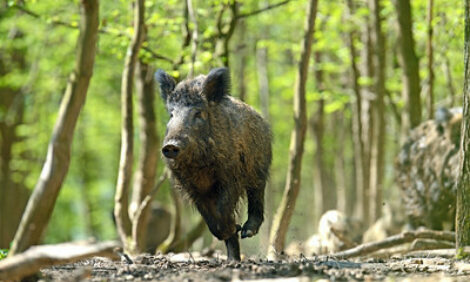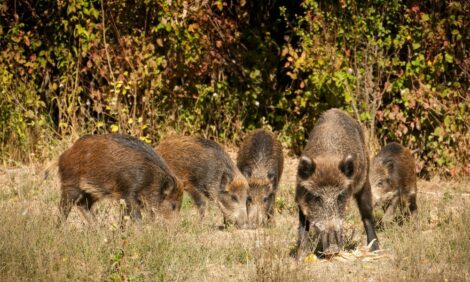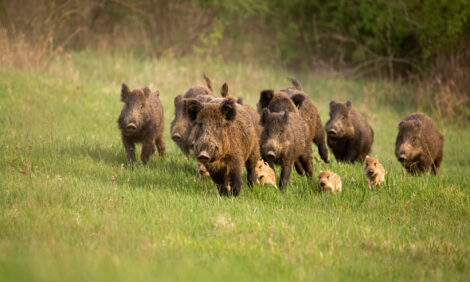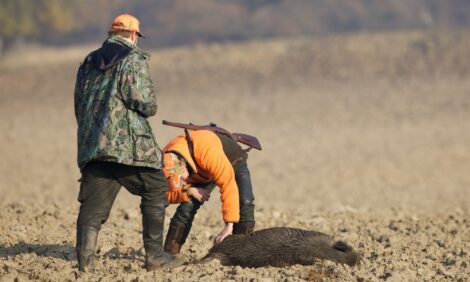



African swine fever in wild boar: implications of extermination
Elimination of wild boar from Eurasian will reduce biological diversity, impact ecological dynamics and forest healthEditor's note: the following is an excerpt from African swine fever in wild boar populations - ecology and biosecurity. It was created by the FAO, WOAH and European Commission. Additional content from the booklet will be shared as an article series.
The elimination of wild boar from Eurasian ecosystems, particularly in the boreal zone where the species has an important ecological role, will further reduce biological diversity and impact ecological dynamics and forest health. From a nature conservation perspective, the extinction of wild boar, even local extinction, should not be viewed as positive or desirable, regardless of whether it is the result of increased ASF-related mortality, depopulation efforts or both. In parts of Southeast Asia, similar effects are expected among endemic suid species that also play an important role in ecosystems and shape plant communities (Luskin et al., 2020).
Hunting pressure on other ungulates, including illegal hunting (poaching), will increase as a result of wild boar extinction. This will further decimate biological diversity and threaten ungulate populations in locations where they are not very abundant. This is particularly relevant in eastern European countries, where ungulate numbers are critically low and will not survive the additional hunting pressure that shifts from wild boar (Danilkin, 2020). Game management experts do not see how wild boar, a core species for recreational hunting, can be substituted by other game species (Danilkin, 2020). In Southeast Asia, local communities face losing wild pigs, such as Sus barbatus in Borneo (Kurtz et al., 2020), a key animal protein source, due to the spread of ASF.
Risk of species extinction for rare endemic Asian suids
The spread of ASF to Asian ecosystems is already impacting wildlife and is anticipated to have severe implications for endemic Asian suids. A recent review by Luskin et al. (2020) indicates that Southeast Asia is a pig diversity hotspot, with 75 percent of global suid species found in this region. Three suid genera occur in Asia: Sus (nine species or subspecies); Babyrusa (three species); and Porcula (one species in Assam, India). The unfolding ASF epidemic in the region raises the need to establish sufficiently large captive populations of some of these species, without which their survival may not be possible (Luskin et al., 2020).
The risk of population crash or extinction due to the spread of ASF is likely to be strongest for the Sus genus (Luskin et al., 2020; listed in order of increasing International Union for Conservation of Nature (IUCN) conservation status and risk evaluation score): Visayan warty pig (Sus cebifrons) critically endangered (CR) risk: very high; Javan warty pig (Sus verrucosus) endangered (EN) risk: high; Sunda bearded pig (Sus barbatus oi) vulnerable (VU) risk: very high; Mindoro warty pig (Sus oliveri) VU risk: very high; Philippine warty pig (Sus philippensis) VU risk: very high; Sunda bearded pig (Sus barbatus barbatus) VU risk: high; Sulawesi warty pig (Sus celebensis) near threatened (NT) risk: very high; Palawan bearded pig (Sus ahoenobarbus) NT risk: high. If ASF were to be introduced, Asian Sus species will likely be strongly impacted, with Malaysia having already reported its first mass mortality due to the disease in Sunda bearded pigs in Borneo.
The situation is also worrying for the Indian endemic Pygmy hog (Porcula salvania; CR risk: high), which had only survived until now due to captive breeding programmes in Assam, India. Unfortunately, ASF was already introduced to this part of India in 2020, meaning this critically endangered species is likely now most at risk.
Although Babyrousa suids all have unfavourable conservation status, overall they seem to be at a lower risk of ASF infection (Togian babirusa (Babyrousa togeanensis) EN risk: Medium; Sulawesi babirusa (Babyrousa celebensis) VU risk: High; Hairy babirusa (Babyrousa babyrussa) VU risk: Low). However, the ecology and epidemiological cycle of ASF in Southeast Asia, and in tropical forests in particular, likely differ from what is observed in temperate latitudes with wild boar, as the habitats and environment of Asian wild suids, their ecology and demographics are different from their Eurasian counterparts. The situation is also complicated by sympatric co-occurrence of different species, their widespread hybridization and the potential involvement of biological or mechanical ASFV vectors.
Cascading effects on rare carnivores
In some areas, and for some species of carnivore, wild boar, particularly juvenile animals, are an important component of their diet. This is the case for the Canis lupus wolf in Italy, for which wild boar comprises 49 percent of the species’ diet (Mori et al., 2016), although the importance of wild boar in wolf diets across Europe may vary (Nores et al., 2008; Sin et al., 2019). The extinction of wild boar in areas where it is an important wolf prey species has the potential to increase the depredation of livestock and other game species and provoke human-wildlife conflict (Mori et al., 2016).
Large felids whose occurrence ranges are now very fragmented may strongly depend on wild boar as a major prey species. For example, the spread of ASF to the far eastern part of the Russian Federation (Primorsky Krai and Amur Oblast) threatens two subspecies of large felids: the Siberian tiger (Panthera tigris tigris; EN) and the Amur leopard (Panthera pardus orientalis; CR). Concerns are being raised that an expected population crash of wild boar due to ASF-related mortality and depopulation efforts could negatively affect these rare felids. Wild pigs also play an important role in the diet of the endemic and critically endangered Sumatran tiger (Panthera tigris sumatrae) and Javan leopard (Panthera pardus melas) in Indonesia (Luskin et al., 2020). The decline of these felids’ main prey species may increase human-wildlife conflicts, thus creating an additional risk factor for their populations (Lubis et al., 2020).
Chapter 3 key messages:
- The large-scale extermination of wild boar as a species to eradicate ASF is an unrealistic, unacceptable and unfeasible task due to ecological, epidemiological, practical and ethical considerations.
- The failure of conventional recreational hunting to level the population growth of wild boar largely relates to the widespread practice of providing supplementary feeding as well as to the highly adaptive behaviour of wild boar, favourable changes in climate and agriculture.
- The restriction of wild boar movements using various types of fencing or odour repellents is not a reliable approach to prevent the spread of ASF, even if the fence is boar-proof. While such methods might be useful in an isolated virus incursion, the restriction of wild boar movements on a large spatial scale and over an extended period of time is problematic and expensive, with low effectiveness in terms of disease control.
- A set of lethal approaches aimed at actively reducing wild boar numbers includes: trapping with euthanasia, which is probably is the easiest way to guarantee biosecurity; the selective shooting of reproductive females; and driven hunts, which should be avoided as they are likely to increase animal and virus dispersion.
- Contraception and poisoning are, respectively, non-lethal and lethal population management methods, both of which are the subject of ongoing research, testing and evaluation. At present, they are not ready for use in temperate European forests and years of efforts are needed to develop them into fully operational, environmentally-safe and ethically-accepted alternatives to currently available solutions.
- The reduction of the population density of wild boar is part of a complex series of measures that could break the transmission cycle of ASF and thus serve as a reliable tool to eradicate the disease. Due to the environmental persistence of ASFV in infected carcasses, virus transmission can continue within very low wild boar population densities.
- Computer simulations show that to prevent the spread of ASF to ASF-free areas, 80 percent of the actual number of wild boar in a 50 km wide strip of habitats would need to be killed or otherwise removed from the population within just 4 months. For a number of reasons, this is almost impossible to attain and the method has never been practically tested.
- Theoretically, prevention can be achieved through a slower population reduction method based on the targeted hunting of reproductive females and a ban on supplementary feeding, but this would require targeted hunting efforts over a minimum of three years and in a much wider (100–200 km) area. Given the current occurrence range of the disease in wild boar, this approach would also be extremely difficult to test empirically.
- It is more realistic to consider the application of different strategic and area-specific population management approaches based on local knowledge and epidemiological information. Efforts should be made to mitigate risks through the application of a complex series of approaches that include hunting, biosecurity measures, the safe disposal of infected carcasses and awareness campaigns.
Guberti, V., Khomenko, S., Masiulis, M. & Kerba S. 2022. African swine fever in wild boar – Ecology and biosecurity. Second edition. Chapter 3. FAO Animal Production and Health Manual No. 28. Rome, FAO, World Organisation for Animal Health and European Commission. https://doi.org/10.4060/cc0785











